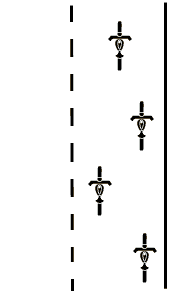

Driving rules
1.
Knowledge about the security, driveability and course of the tour are the basis for an accident-free ride and a great IFMR experience. Every participant has to know the advertised route (maps on board are still essential) he must be able to reach the respective destinations even if he loses the group.
Navigation systems are helpful, but the leader gives the way and sets the pace, everybody follows, even if the GPS shows a different route. Starting a tour means: full tank and voided bladder. The length of the sections is determined by the bike with the smallest range. Refuelling stops are binding for everybody except for those who are absolutely sure of reaching the next stop. Every 90 minutes a break should be scheduled.
2.
The performance of the tour should meet good IFMR- driving and safety practice. The group leader is the head; he is responsible for structure and sequence during the ride and starts the tour with a briefing about all essential details and driveability. He wears a green high visibility vest, the group follows in the so called zig zag system with sufficient distance to the bikes in front (riding in off centre mode, see animation above). At crossings, traffic lights, narrow streets especially in built-up areas the drivers close the gap. Last position in the group (tail-end Charlie) should be manned with an experienced biker wearing a red vest. He should be able to help in various situations and holds his position at all times. A possibility of communication (mobile phone connected) between leader and tail end is preferable. Normally there is no need for overtaking, it should only happen in exceptional circumstances (e.g. informing the leader about stopping the group).
3.
A proper discipline guarantees cohesion and collaborative arrival at the planned destination without losing a group member. Coming to a junction/turning, the leader places the second in the group to a position where he is able to guide the following group in the new direction. This driver must be seen by all the following bikers; he waves his hand and indicates to guarantee that the group takes the scheduled way. He must wait until the last bike of the group (tail-end Charlie) arrives, no matter how long it takes. Before Charlie he merges back into the group (see animation above).
4.
Have a good trip, enjoyable cruises for all IFMR-members and their guests, keep the rubber down and come back safe!
Zasady jazdy
1.
Wiedza na temat bezpieczeństwa, zasad jazdy i przebiegu trasy jest podstawą do bezwypadkowej jazdy i miłych wrażeń z IFMR.
Każdy uczestnik musi znać zaplanowaną trasę (pomocne będzie posiadanie mapy), musi on być w stanie dotrzeć do odpowiednich miejsc, nawet jeśli straci grupę.
Systemy nawigacyjne są pomocne, ale lider wyznacza drogę i ustala tempo, wszyscy podążają za liderem, nawet jeśli GPS pokazuje inną trasę.
Rozpoczęcie wycieczki oznacza: pełny zbiornik paliwa. Długość odcinków jest określana przez motocykl o najmniejszym zasięgu na pełnym zbiorniku. Przystanki na tankowanie są wiążące dla wszystkich, z wyjątkiem tych, którzy są absolutnie pewni, że dotrą do następnego tankowania. Co 90 minut należy zaplanować przerwę.
2.
Przebieg trasy powinien być zgodny z dobrą praktyką jazdy i bezpieczeństwem IFMR. Lider grupy jest odpowiedzialny za strukturę i sekwencję podczas jazdy i rozpoczyna wycieczkę szkoleniem na temat wszystkich istotnych szczegółów i zasad jazdy.
Lider nosi zieloną (bądź inny ustalony kolor) kamizelkę odblaskową, grupa podąża w tak zwanym systemie zygzakowatym (naprzemiennie) z bezpieczną odległością od motocykla poprzedzającego (jazda w trybie środkowym, patrz animacja powyżej).
Na skrzyżowaniach, sygnalizacji świetlnej, wąskich ulicach, szczególnie w obszarach zabudowanych, kierowcy wypełniają lukę.
Ostatnia pozycja w grupie (tail-end Charlie) powinna być obsadzona doświadczonym motocyklistą w czerwonej kamizelce. Powinien być w stanie pomóc w różnych sytuacjach i utrzymuje swoją pozycję przez cały czas.
Preferowana jest możliwość komunikacji (połączenie z telefonem komórkowym) między liderem a ogonem (Charlie). Wyprzedzanie jest zabronione, jedynie w wyjątkowych okolicznościach można wyprzedzić (np. Informowanie lidera o zatrzymaniu grupy).
3.
Właściwa dyscyplina gwarantuje spójność grupy i wspólne przybycie do planowanego miejsca docelowego bez utraty członka grupy.
Jadąc do skrzyżowania / skrętu, lider umieszcza kolejnego motocyklistę z grupy w miejscu, w którym konieczne jest wskazanie kierunku jazdy dla reszty grupy która pozostała z tyłu. Ten motocyklista musi być widziany przez wszystkich nadjeżdżających; macha ręką i wskazuje kierunek i zaplanowaną drogę.
Musi poczekać, aż dotrze ostatni motocykl z grupy (Charlie), bez względu na to, jak długo to potrwa. Przed Charlim wraca do grupy (patrz animacja powyżej).
4.
Życzymy bezpiecznej drogi, przyjemnych tras dla wszystkich członków IFMR i ich gości, lewa w górę i wracajcie bezpiecznie!
Visits: 695
